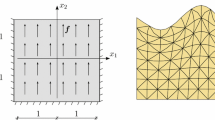Summary
In the paper, we examine the ability of different finite element enhancements to capture localized failure in elasto-plastic solids. Altogether seven variations of four noded elements are studied, from the standard bilinear quadrilateral up to recent mixed strain-displacement expansions. The weak form of localization determines whether an element is capable to reproduce discontinuous bifurcation for elasto-plastic material properties which exhibit a singularity of the localization tensor in the element domain. Both, discontinuous tensile splitting and shear banding are examined in square and quadrilateral element, geometries within the frame of associated and non-associated elasto-plastic Rankine-and Drucker-Prager descriptions. Aside from spectral studies of discontinuous bifurcation on the element level, the effect of progressive failure computations is examined with the help of two boundary value problems.
Übersicht
In diesem Artikel untersuchen wir die Eignung verschiedener Finite-Element-Formulierungen zum Erfassen lokalisierten Versagens in elasto-plastischen Materialien. Es werden insgesamt sieben verschiedene 4-Knoten-Elemente betrachtet, vom bilinearen Standard-Viereckelement bis zu jüngsten gemischten Verzerrungs-Verschiebungs-Ansätzen. Der schwache Lokalisierungstest bestimmt ob ein Element in der Lage, ist, diskontinuierliche Verzweigung auf konstitutiver Ebene auch auf Elementebene zu reflektieren. Ein elasto-plastisches Material verzweigt, diskontinuierlich, sobald der akustische Tensor singulär wird. Sowohl diskontinuierliche Zugbruch-als auch Schubbandversagensformen werden für allgemein viereckige und quadratische Elementgeometrien im Rahmen von assoziierten und nicht assoziierten Rankine-und Drucker-Prager-Beschreibungen untersucht. Neben den spektralen Eigenschaften der diskontinuierlichen Verzweigung auf Elementebene wird der Effekt der progressiven Versagensberechnung anhand von zwei Randwertproblemen untersucht.
Similar content being viewed by others
References
Vardoulakis, I.: Bifurcation analysis of the triaxial test on sand samples. Acta Mech. 32 (1979) 35–54
Nagtegaal, J. C.; Parks, D. M.; Rice, J. R.: On numerical accurate finite element solutions in the fully plastic range. Comp. Meth. Appl. Mech. Engr. 4 (1974) 153–177
Hughes, T. J. R.: The finite element method. Englewood Cliffs, New Jersey: Prentice-Hall 1987
Ortiz, M.; Leroy, Y. Needleman, A.: A finite element method for localization failure analysis. Comp. Meth. Appl. Mech. Engr. 61 (1987) 189–224
Sobh, N.: Bifurcation analysis of tangential material operators. Ph. D. Dissertation, CEAE Department, University of Colorado, Boulder, 1987
Willam, K.; Sobh, N.; Sture, S.: Elastic-plastic tangent operators: Localization studies on the constitutive and finite element levels. In: ASME-WAM'87 Symp. Advances in inelastic analysis, Boston 1987 Vol. 88, pp. 107–127, Nakazawa, S.; Rebelo, N.; Willam K. (eds.) New York: ASME, 1987
Mirsky, L.: An introduction to linear algebra. New York: Dover 1983
Rudnicki, J. W.; Rice, J. R.: Conditions for the localization of deformation in pressure-sensitive dilatant materials. J. Mech. Phys. Solids 10 (1962) 1–16
Zienkiewicz, O. C.; Taylor, R. L.: The finite element method (4th ed.). London: McGraw-Hill 1989
Cook, R. D.; Malkus, D. S.: Plesha, M. E.: Concepts and applications of the finite element analysis (3rd ed.). New York: John Wiley & Sons 1989
Doherty, W. P.; Wilson, E. L.; Taylor, R. L.: Stress analysis of axissymmetric Solids utilizing higher order quadrilateral finite elements. SESM-Report 69-3, University of California Berkely, 1969
Wilson, E. L.; Taylor, R. L.; Doherty, W. P.; Ghaboussi, J.: Incompatible displacement models. In: Fenves, S. J. et al. (eds.) Numerical and computer models in structural mechanics, pp. 43–57. New York: Academic Press 1973
Taylor, R. L.; Beresford, P. J.; Wilson, E. L.: A non-conforming element for stress analysis. Int. J. Num. Meth. Engr. 10 (1976) 1211–1219
Willam, K. J.: Finite element analysis of cellular structures. Ph. D.-Dissertation., University of California, Berkeley, 1969
Argyris, J. H.; Willam, K. J.: Some considerations for the evaluation of finite element models. Nucl. Engr. Design, 28 (1974) 76–96
MacNeal, R. H.: A simple quadrilateral shell element. Computers and structures 8 (1978) 175–183
Malkus, D. S.; Hughes, T. J. R.: Mixed finite element methods-Reduced and selective integration techniques: a unification of concepts. Comp. Meth. Appl. Mech. Engr. 15 (1978) 63–81
Simo, J. C.; Rifai, M. S.: A class of mixed assumed strain methods and the method of incompatible modes. Int. J. Num. Meth. Engr. 29 (1990) 1595–1638
Pian, T. H. H.; Sumihara, K.: Rational approach for assumed stress finite elements. Int. J. Num. Meth. Engr. 20 (1985) 1658–1695
Belytschko, T.; Bachrach, W. E.: Efficient implementation of quadrilaterals, with high coarse-mesh accuracy. Comp. Meth. Appl. Mech. Engr. 23 (1986) 323–331
de Borst, R.: Numerical methods for Bifurcation, analysis in geomechanics. Ing. Arch. 59 (1989) 160–169
Ortiz, M.: Private communication (1990)
Simo, J. C.: A class of mixed assumed strain methods and the method of incompatible modes (lecture at workshop on Computational Methods in Solid Mechanics, Oberwolfach, Oct 29–Nov 4, 1989)
Author information
Authors and Affiliations
Rights and permissions
About this article
Cite this article
Steinmann, P., Willam, K. Finite elements for capturing localized failure. Arch. Appl. Mech. 61, 259–275 (1991). https://doi.org/10.1007/BF00794351
Received:
Issue Date:
DOI: https://doi.org/10.1007/BF00794351




